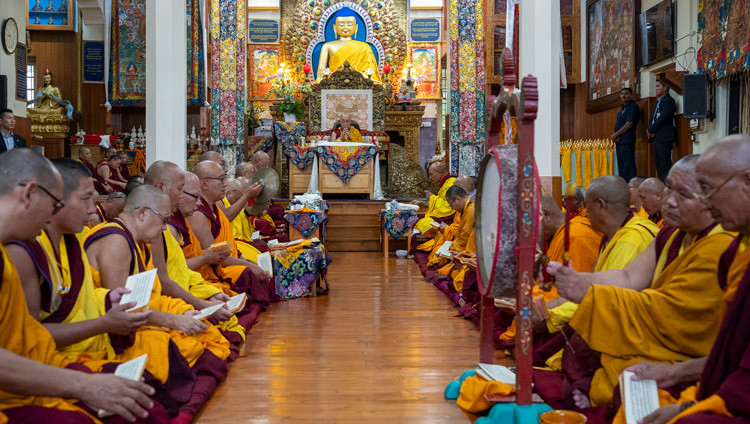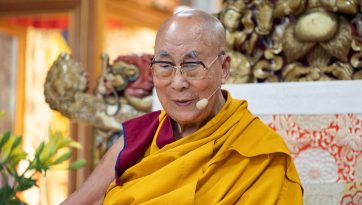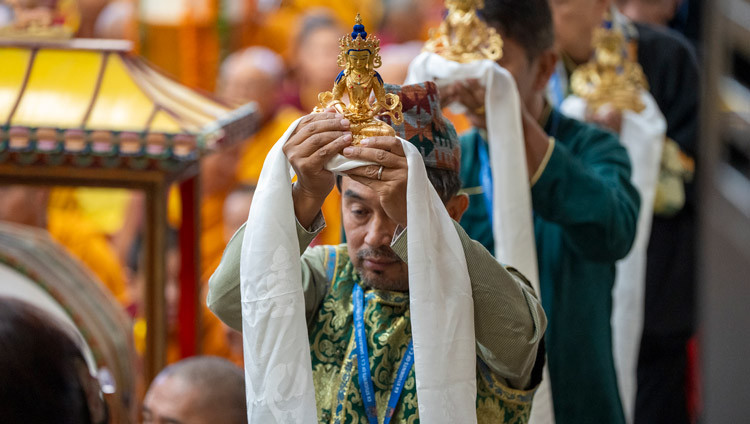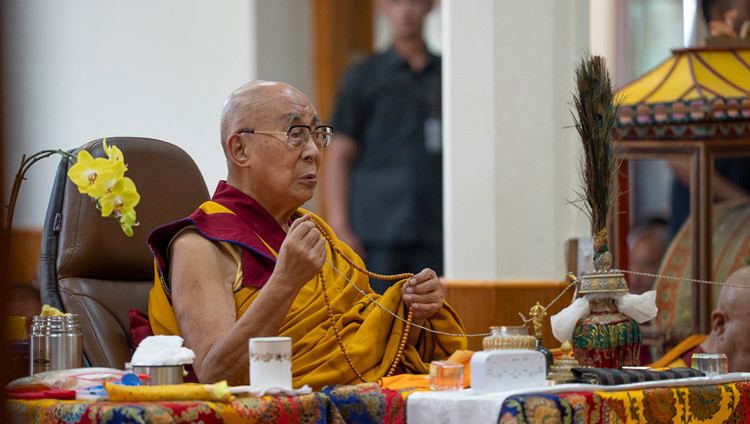Three Principal Aspects of the Path
March 13, 2021
Thekchen Chöling, Dharamsala, HP, India – Once the formalities of reciting the ‘Heart Sutra’ and offering the mandala were complete this morning, His Holiness the Dalai Lama began to speak.
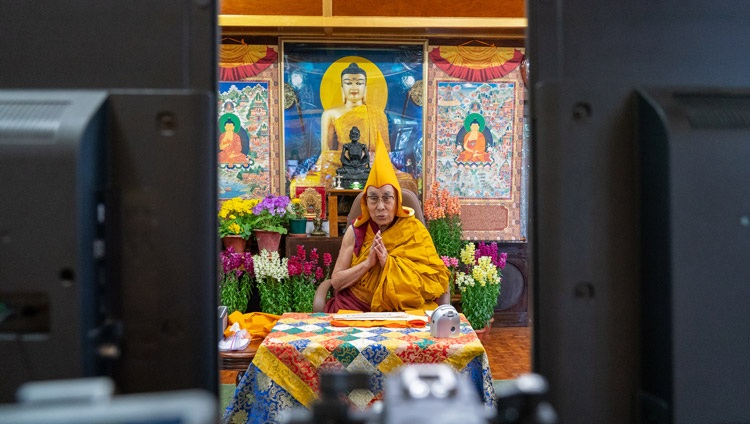
“Today, this webcast is intended primarily for those of you in the great nation of Mongolia. The text I’m going to teach is the ‘Three Principal Aspects of the Path’ which is included among Jé Tsongkhapa’s miscellaneous writings. It was written in response to a request from one of his close disciples Tsakho Önpo Ngawang Drakpa who was in Gyalmorong, Eastern Tibet.
“Jé Rinpoché promised him that if he followed his instructions well, when he, Tsongkhapa, became a Buddha, he would share the first nectar of his teaching with him. In the final verse of the text the reference to ‘my son’, can be taken to include all of us too.
“I was born in the same region as Jé Rinpoché and as well as the physical proximity, I feel close to him in spirit too. We should practise as he advised Ngawang Drakpa, remembering that the Buddhas do not wash away unwholesome deeds with water, nor do they remove the sufferings of beings with their hands, neither do they transplant their own realization into others. It’s by teaching the truth of suchness that they liberate beings.
“As it is also said, ‘You are your own master’. We need to learn and practise accordingly, developing single-pointed concentration and applying it in analytical meditation.
“Jé Rinpoché’s writings fill eighteen volumes. We should read them, reflect on what they say and meditate on what we’ve understood. His sources were Nagarjuna and Chandrakirti, whose ‘Entering into the Middle Way’, with its auto-commentary I keep close by and read whenever I have time. As far as the awakening mind of bodhichitta is concerned I rely on Shantideva’s marvellous ‘Entering into the Way of a Bodhisattva’.
“In order to help other beings, we need to attain the Buddha’s form body which entails eliminating all defilements and accumulating a powerful collection of merit.
“As soon as I wake in the morning, I cultivate bodhichitta and recite verses from ‘Entering into the Middle Way’. The late Kyörpön Rinpoché said that if you read Tsongkhapa’s five books on the Middle Way: ‘Ocean of Reasoning’; ‘Elucidation of the Thought’; the ‘Great Exposition of Special Insight’; the ‘Medium Exposition of Special Insight’ and ‘Essence of Eloquence’, you will gain insight into emptiness. But, it’s not just a matter of reading them once. You need to read them again and again. Doing so will yield conviction.
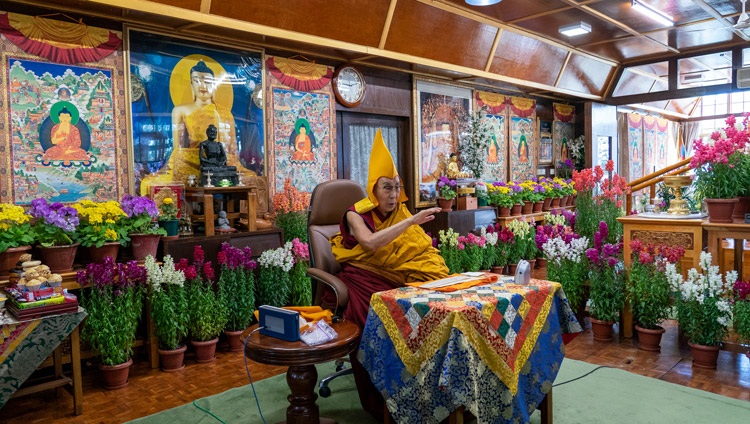
“My own reflections on the Middle Way and bodhichitta are not just an intellectual exercise, they bring me peace of mind. I feel I’m being true to Jé Rinpoché’s exhortation to practise sincerely.”
His Holiness began his reading of the text by clarifying that the three principal aspects of the path are the determination to be free, the awakening mind of bodhichitta and the correct view of emptiness. The text opens with homage to the teachers and a humble promise to ‘explain as well as I am able the essence of all the teachings of the Conqueror’. Receptive disciples are urged to listen to the teaching.
Without a pure determination to be free there is no way to still attraction to the pleasures of cyclic existence, the whole of which is a function of karma and mental afflictions. They are rooted in ignorance. Therefore, it’s necessary to seek a determination to be free. ‘There is no time to waste’ touches on impermanence. Change moment by moment is subtle impermanence; death is its coarse aspect.
His Holiness indicated that verses three, four and five outline the reason for generating a determination to be free, how to cultivate it and the measure of having done so. Next is the need to develop the awakening mind of bodhichitta without which we won’t achieve the omniscience of Buddhahood.
Verse seven outlines the way to do this by reflecting on how sentient beings are swept by the current of the four powerful rivers—birth, aging, sickness and death. They are tied by strong bonds of actions, so hard to undo. They are caught in the iron net of self-centredness—completely enveloped by the darkness of ignorance.
All beings, your mothers, are born and reborn in boundless cyclic existence, ceaselessly tormented by the three miseries. Thinking of them, generate the awakening mind.
Although verses seven and eight were intended to show how to cultivate bodhichitta, His Holiness also likes to change their focus from all mother sentient beings to himself as a means to strengthen his determination to be free.
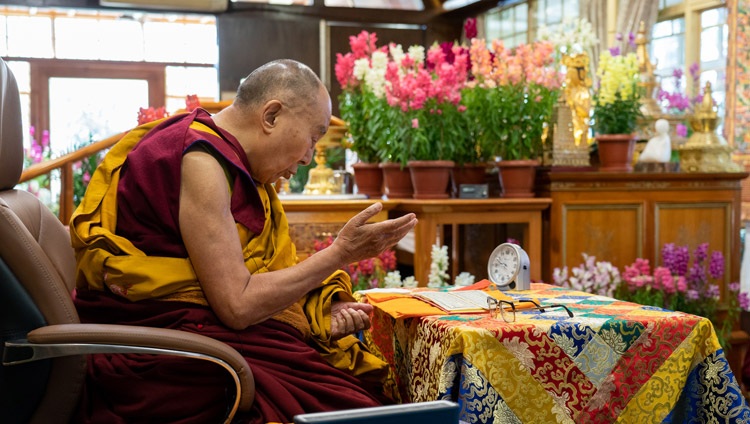
He pointed out that there are two approaches for developing the awakening mind: the seven-point cause and effect instruction and the method of exchanging yourself with others. He was clear that the latter approach is more powerful and quoted what Shantideva has to say.
For those who fail to exchange their own happiness for the suffering of others, Buddhahood is certainly impossible—how could there even be happiness in cyclic existence? 8/131
Proceeding in this way from happiness to happiness, what thinking person would despair, after mounting the carriage, the awakening mind, which carries away all weariness and effort? 7/30
The key to verse nine, since, even though you may practise the determination to be free and the awakening mind, without wisdom, the realization of emptiness, you cannot cut the root of cyclic existence, is to strive to understand dependent arising.
“As Aryadeva observed in his ‘400 Verses’,” His Holiness declared, “ignorance of reality permeates all mental afflictions just as a sense of tactility pervades the body. By destroying ignorance, the mental afflictions are eliminated. Things appear as if they have some existence from their own side. We don’t see self as something merely designated. There are philosophical schools who posit consciousness as the person. From among the psycho-physical aggregates they pick one thing to be the person. Consequentialists (Prasangikas) do not accept this.”
His Holiness cited three verses from the sixth chapter of Chandrakirti’s ‘Entering into the Middle Way’ which outline the logical absurdities that ensue when objective existence is asserted.
If the intrinsic characteristics of things were to arise dependently,
things would come to be destroyed by denying it;
emptiness would then be a cause for the destruction of things.
But this is illogical, so no real entities exist. 6/34
Thus, when such phenomena are analysed,
nothing is found as their nature apart from suchness.
So, the conventional truth of the everyday world
should not be subjected to thorough analysis. 6/35
In the context of suchness, certain reasoning disallows arising
from self or from something other, and that same reasoning
disallows them on the conventional level too.
So, by what means then is your arising established? 6/36
If things could be pinpointed as this or that, a noble being’s mind absorbed in emptiness would find nothing whatever exists. There would be no objective existence whatsoever. Then that mind would be a destroyer of entities. Moreover, the conventional reality of things would withstand the probing of an analytical or reasoning mind. When you do critical analysis of how things exist, you’ll not find any true identity that you can point at. Therefore, you conclude that things exist merely by designation.
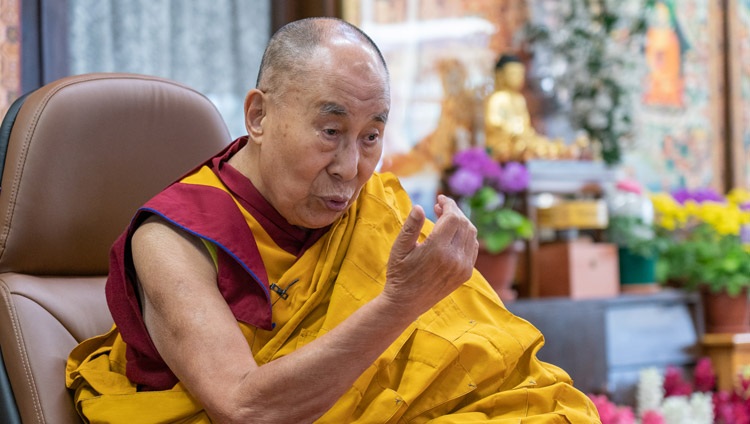
If you actually assert the objective existence of things, the absolute production of things cannot be denied. In addition to these points, in the auto-commentary to ‘Entering into the Middle Way’, Chandrakirti quotes from the sutras and states that in the face of an assertion of the objective existence of things, the Buddha’s declaration that phenomena lack self-existence would not hold true. He also states that if you apply the seven-fold analysis, nothing can be found and yet things still exist conventionally.
Jé Rinpoché writes ‘strive to understand dependent arising.’ Choné Lama Rinpoché, in his versified commentary to Tsongkhapa’s ‘In Praise of Dependent Arising’, wrote ‘Dependence does not deny suchness; arising does not deny worldly convention.’ The Buddha taught dependent arising and the two truths. Things appear to exist, which is conventional reality. Ultimate reality is how they exist. Dependent arising is like the king of reasons.
Someone who sees the infallible cause and effect of all phenomena in cyclic existence and peace, and destroys all false perceptions, has entered the path which pleases the Buddha. Appearances are infallible dependent arising; emptiness is free of assertions. As long as these two understandings are seen as separate, you have not yet realized the intent of the Buddha. When these two realizations are simultaneous and concurrent, from a mere sight of infallible dependent arising comes certain knowledge which completely destroys all modes of mental grasping. At that time the analysis of the profound view is complete.
Emptiness does not mean there’s nothing there. Things and beings are empty of how they appear to us. Because they are dependent, things have no independent existence. When we don’t analyse them, things exist, but only by way of convention.
“Jé Rinpoché’s final advice to Ngawang Drakpa, ‘Son, depend on solitude and strong effort, and quickly reach the final goal’, can apply to us too. When you are reciting the verses of the Hundred Deities of the Joyous Land, imagine that he says these words to you. The text concludes, ‘This advice was given by the monk Lobsang Drakpai Pal to Ngawang Drakpa from Tsakho.’
“Monks and nuns, my Mongolian Dharma friends among them, are studying well in the great monastic centres of learning. In Tibet, as well as in South India, students are studying sincerely. Remember that the purpose of study is to integrate the teaching within you in order that you become a better person.
“If those of you in Outer Mongolia have the opportunity to help those in Inner Mongolia and so forth, please do so. This is one of the places where the Buddhadharma had spread before, but has declined. I have a connection with Inner Mongolia because one of my debate partners, Ngodup Tsognyi was from there. He coached me in debate. My admiration for and interest in the Middle Way was kindled by him. He told me, ‘Your Senior Tutor is a great scholar and master of philosophical treatises, Your Junior Tutor is an expert in the ‘Stages of the Path’ literature. You should integrate both traditions within you.’
“Those of you who are members of the three Great Seats of Learning have been studying well. I urge you to continue to do so. Despite great hardship, we have kept our traditions alive for more than a thousand years. This Nalanda Tradition we have preserved is like the very core of our culture and identity. The same can be said about Mongolia. These days, scientists are showing interest in what we know. We shouldn’t feel we’ve somehow been left behind. People talk about peace in the world, but we won’t achieve it without first attaining peace of mind. Please continue to do your best.”
While answering questions from the audience, His Holiness explained that prayer, chanting, prostration and circumambulation, as well as the construction of stupas, are all ways to purify defilements and gather merit. In the long run they will contribute to the attainment of enlightenment for the sake of all sentient beings. In the meantime, he said, it’s good to try to do them within the framework of the three principal aspects of the path.
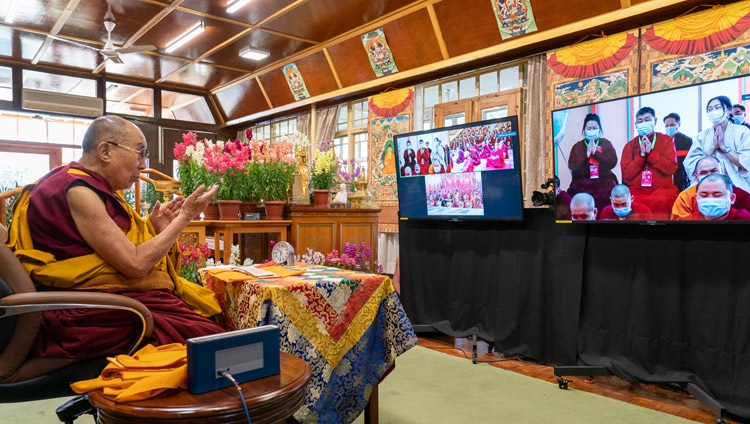
He agreed that the Buddha’s teaching can certainly have a positive impact on family life and the upbringing of children. He pointed out that, from a practical point of view, Shantideva’s ‘Entering into the Way of a Bodhisattva’ is easy to read. Chapters six and eight in particular contain advice that children may heed about not getting angry but behaving with kindness. As Shantideva says:
All those who suffer in the world do so because of their desire for their own happiness. All those happy in the world are so because of their desire for the happiness of others. 8/129
His Holiness conceded that in the past peoples were ruled by kings and queens. There were distinctions of class, caste and social status. These days, increasingly, democracy prevails. When people are equal there’s more opportunity to be concerned for the welfare of others.
As brief prayers were being said for His Holiness’s long life, he remembered that he wanted to conduct a ceremony for generating the awakening mind of bodhichitta. He encouraged the audience to imagine the Buddha in front of them surrounded by Indian, Tibetan and Mongolian masters and to think of him as the Buddha’s messenger. He then led the congregation in reciting the following verses three times.
I seek refuge in the Three Jewels;
Each and every wrongdoing I confess.
I rejoice in the virtues of all beings.
I take to heart the state of Buddhahood.
I go for refuge until I am enlightened
To the Buddha, the Dharma, and the Supreme Assembly,
In order to fulfil the aims of myself and others
I develop the awakening mind.
Having developed the aspiration for highest enlightenment,
I invite all sentient beings as my guests,
I shall enact the delightful supreme enlightening practices.
May I become a Buddha to benefit all sentient beings.
The ceremony concluded with celebratory verses from ‘Entering into the Way of a Bodhisattva’.
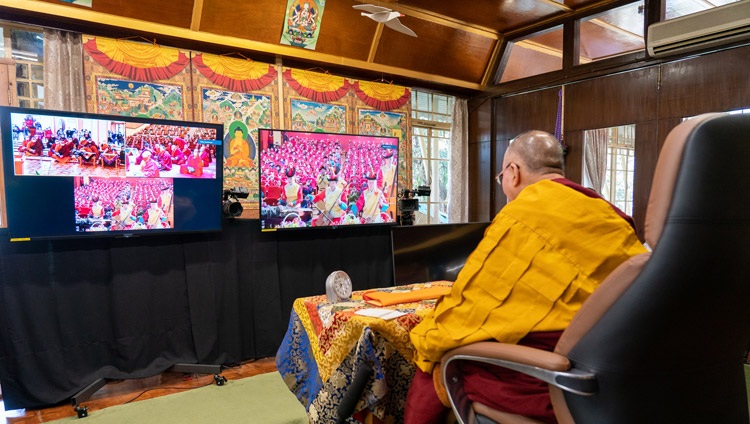
A group of young Mongolians from the Bayankhongor region performed a musical rendition of Om mani padme hum to the accompaniment of traditional instruments.
N Tuvshintur, head of an NGO called Lamiin Gegeen Mongol Sunchoi thanked His Holiness for the teaching he had graciously given. He also thanked staff of Gandantegchenling, the Central Monastery of Mongolian Buddhism, and everyone else who had contributed to organizing the event. He ended with the following auspicious verse:
May Your Holiness the Dalai Lama
Remain with us for a hundred aeons
Blessing the people of Mongolia
And may you visit us again and again.
His Holiness expressed thanks in return and waved as the series of teachings came to an end.
SOURCE: https://www.dalailama.com/news/2021/three-principal-aspects-of-the-path





